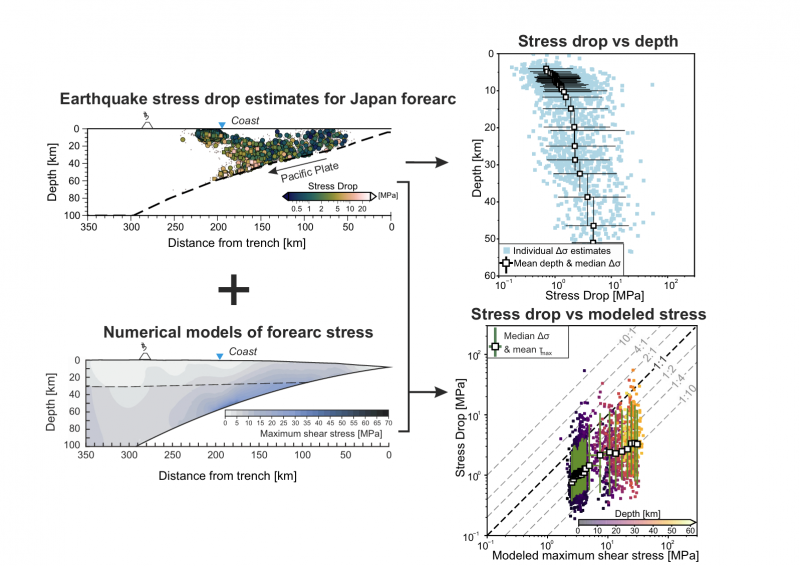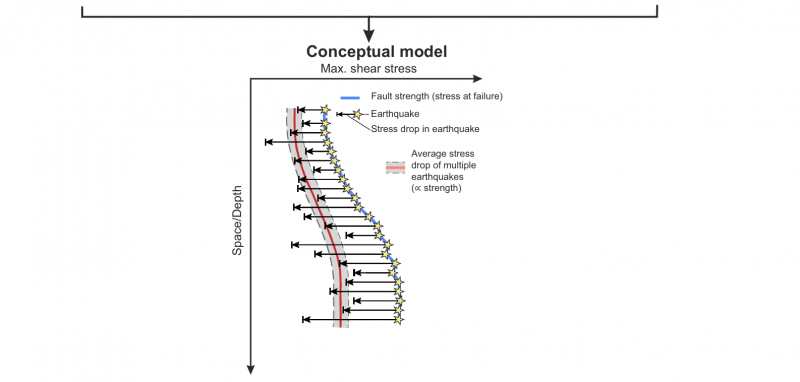
New Study Connects Earthquake Energy Release to the Strength of Rocks Beneath Our Feet
Why do some earthquakes release more energy than others? And what does that reveal about the strength of rocks deep beneath the Earth’s surface?
As tectonic plates slowly slide past one another, stress builds up along faults. When that stress exceeds the maximum amount of stress that a fault can sustain, known as strength, the stress is eventually released in an earthquake. The amount of stress release can be measured, but measuring the total amount of stress that build-up before an earthquake happens is difficult. It makes intuitive sense that stronger rocks should build up and release more stress, but confirming that assumption has remained elusive, to date. New findings from a study by Bocchini et al. now show that the stronger or deeper a fault in the Earth’s crustal rock is, the more stress it releases during an earthquake.
The study was published in the online journal Communications Earth & Environment.
A measurable indication of the strength of the Earth's crust
This finding has far-reaching implications. It shows that seismological data can be used to determine how strong rocks are at a specific location on average (in a relative sense), i.e. how much stress they can bear before breaking. The implication is that it is possible indirectly to determine the relative strength of the Earth's crust on average, and how it changes in space and time, something that is difficult to do.
“Our results provide a physical basis for the relationship between the release of stress during earthquakes and the strength of the faults,” explains Gian Maria Bocchini from the Institute of Geosciences at Ruhr University Bochum. “This means we can use seismological data to draw conclusions about the relative strength of the Earth’s crust. This is something that has been difficult to prove until now.”

Analyses in north-eastern Japan
For their analysis, the research team evaluated earthquake data from northeastern Japan in the 11 years following the Mw 9.0 Tohoku-Oki earthquake in 2011. The region is one of the most seismically active areas in the world and is monitored by a dense network of high-quality borehole seismic stations.
The evaluation showed a clear pattern: the deeper an earthquake occurs, the greater the stress drop, and the more energy is released.
To explain this trend, the researchers compare results from numerical finite element models that simulate forces in the Earth's crust to stress drop measurements from seismological data. The comparison shows that the stress drop increases with the maximum shear stress, i.e. the greatest lateral force that faults can withstand before it breaks.
Significance for earthquake research
The study offers a physical explanation for the relationship between stress drop and depth of an earthquake and helps to understand seemingly conflicting results from previous research. It shows that stronger or deeper faults can withstand higher stresses and therefore show greater stress drops. This allows conclusions to be drawn about relative fault strength, a value that is difficult to measure on a broad scale. "Interestingly, the stress drop values have barely changed in all the years following the Tohoku-Oki earthquake," notes Armin Dielforder of the University of Greifswald. "The strength of faults appears to be constant over time, which may help understand aftershock sequences." In the long term, this research provides a new basis for better understanding earthquake processes and modelling the mechanical properties of the Earth's crust more accurately.

Participating Institutions:
Ruhr University Bochum, Institute of Geosciences
University of Greifswald, Institute for Geography and Geology
U.S. Geological Survey, Earthquake Science Center, Pasadena (USA)
Original Publication:
Bocchini, G. M., Dielforder, A., Kemna, K. B., Harrington, R. M., & Cochran, E. S.: Earthquake stress-drop values delineate spatial variations in maximum shear stress in the Japanese forearc lithosphere, in: Communications Earth & Environment, 2025, https://doi.org/10.1038/s43247-025-02877-y
Figure Description (Schematic summary of the study by Bocchini et al. (2025))
The study analyzes the relationship between earthquake stress drop, depth, and shear stress in the forearc of northeastern Japan. Stress drop (Δσ) values are derived from thousands of aftershocks of the 2011 Mw 9.0 Tohoku–Oki earthquake and display a systematic increase with depth. Finite-element numerical models of force balance estimate the absolute shear stress in the forearc lithosphere. Comparison of observed stress drop with modeled shear stress reveals a positive correlation, providing quantitative evidence that earthquake stress-drop scales with fault strength, i.e. maximum shear stress at failure. The results indicate that stress drop can serve as a seismological proxy for relative crustal strength in the brittle lithosphere.